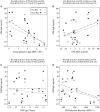Known Allergen Structures Predict Schistosoma mansoni IgE-Binding Antigens in Human Infection
- PMID: 25691884
- PMCID: PMC4315118
- DOI: 10.3389/fimmu.2015.00026
Known Allergen Structures Predict Schistosoma mansoni IgE-Binding Antigens in Human Infection
Abstract
The IgE response has been associated with both allergic reactions and immunity to metazoan parasites. Recently, we hypothesized that all environmental allergens bear structural homology to IgE-binding antigens from metazoan parasites and that this homology defines the relatively small number of protein families containing allergenic targets. In this study, known allergen structures (Pfam domains) from major environmental allergen families were used to predict allergen-like (SmProfilin, SmVAL-6, SmLipocalin, SmHSP20, Sm triosephosphate isomerase, SmThioredoxin, Sm superoxide dismutase, SmCyclophilin, and Sm phosphoglycerate kinase) and non-allergen-like [Sm dynein light chain (SmDLC), SmAldolase SmAK, SmUbiquitin, and Sm14-3-3] proteins in Schistosoma mansoni. Recombinant antigens were produced in Escherichia coli and IgG1, IgG4, and IgE responses against them measured in a cohort of people (n = 222) infected with S. mansoni. All allergen-like antigens were targeted by IgE responses in infected subjects, whilst IgE responses to the non-allergen-like antigens, SmAK, SmUbiquitin, and Sm14-3-3 were essentially absent being of both low prevalence and magnitude. Two new IgE-binding Pfam domain families, not previously described in allergen family databases, were also found, with prevalent IgE responses against SmDLC (PF01221) and SmAldolase (PF00274). Finally, it was demonstrated that immunoregulatory serological processes typically associated with allergens also occurred in responses to allergen-like proteins in S. mansoni infections, including the production of IgG4 in people responding with IgE and the down-regulation of IgE in response to increased antigen exposure from S. mansoni eggs. This study establishes that structures of known allergens can be used to predict IgE responses against homologous parasite allergen-like molecules (parallergens) and that serological responses with IgE/IgG4 to parallergens mirror those seen against allergens, supporting our hypothesis that allergenicity is rooted in expression of certain protein domain families in metazoan parasites.
Keywords: IgE; IgG4; allergenicity; helminth proteins; metazoan parasite; parasite allergens; schistosomiasis mansoni.
Figures






Similar articles
-
The Schistosoma mansoni tegumental-allergen-like (TAL) protein family: influence of developmental expression on human IgE responses.PLoS Negl Trop Dis. 2012;6(4):e1593. doi: 10.1371/journal.pntd.0001593. Epub 2012 Apr 3. PLoS Negl Trop Dis. 2012. PMID: 22509417 Free PMC article.
-
Parasite allergens.Mol Immunol. 2018 Aug;100:113-119. doi: 10.1016/j.molimm.2018.03.014. Epub 2018 Mar 24. Mol Immunol. 2018. PMID: 29588070 Review.
-
Factors affecting human IgE and IgG responses to allergen-like Schistosoma mansoni antigens: Molecular structure and patterns of in vivo exposure.Int Arch Allergy Immunol. 2007;142(1):40-50. doi: 10.1159/000095997. Epub 2006 Oct 2. Int Arch Allergy Immunol. 2007. PMID: 17019080
-
Allergen skin test reactivity and asthma are inversely associated with ratios of IgG4/IgE and total IgE/allergen-specific IgE in Ugandan communities.Clin Exp Allergy. 2021 May;51(5):703-715. doi: 10.1111/cea.13834. Epub 2021 Feb 5. Clin Exp Allergy. 2021. PMID: 33512036 Free PMC article.
-
Helminth Allergens, Parasite-Specific IgE, and Its Protective Role in Human Immunity.Front Immunol. 2014 Feb 14;5:61. doi: 10.3389/fimmu.2014.00061. eCollection 2014. Front Immunol. 2014. PMID: 24592267 Free PMC article. Review.
Cited by
-
Antigenic cross-reactivity between Schistosoma mansoni and peanut: a role for cross-reactive carbohydrate determinants (CCDs) and implications for the hygiene hypothesis.Immunology. 2017 Apr;150(4):506-517. doi: 10.1111/imm.12711. Epub 2017 Feb 15. Immunology. 2017. PMID: 28201853 Free PMC article.
-
Antibody responses to Schistosoma mansoni schistosomula antigens.Parasite Immunol. 2018 Dec;40(12):e12591. doi: 10.1111/pim.12591. Epub 2018 Oct 14. Parasite Immunol. 2018. PMID: 30239012 Free PMC article.
-
Schistosoma mansoni venom allergen-like protein 6 (SmVAL6) maintains tegumental barrier function.Int J Parasitol. 2021 Mar;51(4):251-261. doi: 10.1016/j.ijpara.2020.09.004. Epub 2020 Nov 28. Int J Parasitol. 2021. PMID: 33253697 Free PMC article.
-
Protective human IgE responses are promoted by comparable life-cycle dependent Tegument Allergen-Like expression in Schistosoma haematobium and Schistosoma mansoni infection.PLoS Pathog. 2023 May 25;19(5):e1011037. doi: 10.1371/journal.ppat.1011037. eCollection 2023 May. PLoS Pathog. 2023. PMID: 37228019 Free PMC article.
-
Composition of the Schistosoma mansoni worm secretome: Identification of immune modulatory Cyclophilin A.PLoS Negl Trop Dis. 2017 Oct 26;11(10):e0006012. doi: 10.1371/journal.pntd.0006012. eCollection 2017 Oct. PLoS Negl Trop Dis. 2017. PMID: 29073139 Free PMC article.
References
Grants and funding
LinkOut - more resources
Full Text Sources
Other Literature Sources

